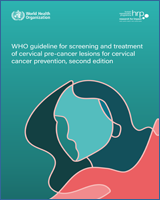6.1. Guideline dissemination and impact
The final published guideline document will be disseminated using WHO’s worldwide network to make sure that the guideline reaches health-care providers and programme managers so that the most recent evidence is integrated and accessible for clinical decision-making to prevent cervical cancer. A link to download the guideline will be available at the WHO website and in HRP News,9 and printed copies, if requested, will be disseminated to health ministries, WHO country and regional offices, WHO collaborating centres on cervical cancer, and other cervical cancer collaborators and partners.
The print and electronic copies will be disseminated at high-level meetings for advocacy, and at international conferences to reach a large audience, especially through special sessions, seminars and satellite sessions. Policy briefs for women living with HIV and for sexual and reproductive health programmes will also be developed.
The new recommendations regarding women living with HIV will be included in the forthcoming third edition of the WHO consolidated guideline on HIV (38). This represents an opportunity for dissemination through other WHO department networks and to ensure that the community of people living with HIV is aware of and implements the relevant recommendations.
These dissemination plans also include partners involved in the implementation and roll-out of cervical cancer screening and treatment. These include other United Nations agencies, the United States President’s Emergency Fund for AIDS Relief (PEPFAR), the Global Fund and Unitaid. Lastly, an app will be developed to make the guideline interactive and accessible on smartphones.
In the context of the Global strategy to accelerate the elimination of cervical cancer, launched in November 2020, this guideline is particularly important in shaping national plans to meet the 2030 targets. These recommendations will inform programme development, and WHO and partners will make every effort to support countries to update their national cervical cancer guidelines. The guideline will be translated into the six WHO official languages.
WHO headquarters will work with WHO regional offices and country offices to ensure that countries will be supported in the adaptation, implementation and monitoring of the guideline. For this purpose, regional workshops and webinars in different languages will be organized to present, discuss and plan guideline adaptation and implementation, as well as to update current national guidelines. At all levels (headquarters, regional offices and countries), WHO will work with regional and national partners, as well as other United Nations agencies such as the United Nations Population Fund (UNFPA), the United Nations Children’s Fund (UNICEF), the International Atomic Energy Agency (IAEA) and the Joint United Nations Programme on HIV/AIDS (UNAIDS) (39). The guideline will be disseminated at upcoming major conferences related to sexual and reproductive health and rights, HPV, HIV and public health. Other WHO guidance is available to support impact evaluation, national programme reviews, planning, implementation and scale-up (40,41,42).
In addition, impact will be measured by developing and disseminating surveys for both health workers and clients, as was done during the guideline development for values and preferences. This will be done a year after release to assess any changes in country policies and national guidelines. This will also assess the reach of the guideline and ultimately its impact in changing practice.
Over the next year, WHO’s Comprehensive cervical cancer control: a guide to essential practice, which was last published in 2014 (5), will be revised to provide an up-to-date and global consolidation of all recommendations to prevent cervical cancer.
6.2. Guideline update
In this guideline, the GDG prioritized seven algorithms. Additional algorithms that will be covered in a future version of this guideline will include the use of HPV mRNA detection, DNA methylation, p16/Ki-67 dual-staining cytology and automated visual evaluation. Evidence for the sensitivity and specificity of these tests and the impact on important outcomes of using them in programmes is accumulating, and syntheses of this evidence are needed. These syntheses will be used in a continual process to develop new recommendations, as “living recommendations” in Phase 4 of the guideline update.
The GDG will continue to work with the WHO Secretariat in an ad hoc manner, so that the research gaps identified during the process can be addressed. Additionally, Phase 4 of this guideline update process is to establish living recommendations (43) for screening and treatment tests and algorithms. The GDG anticipates that as data and experience with new screening tests and modalities advance, new recommendations will be needed through a living guideline process that is able to rapidly respond and evolve.

